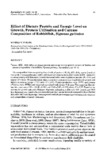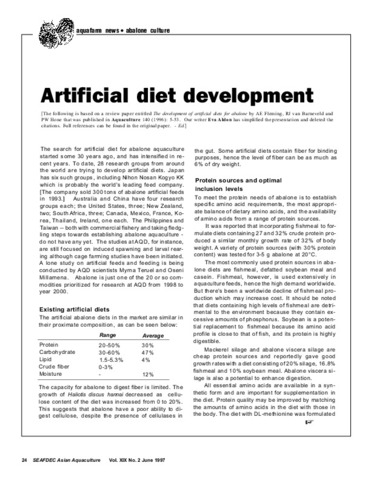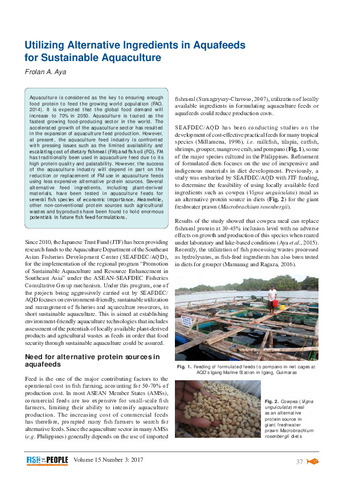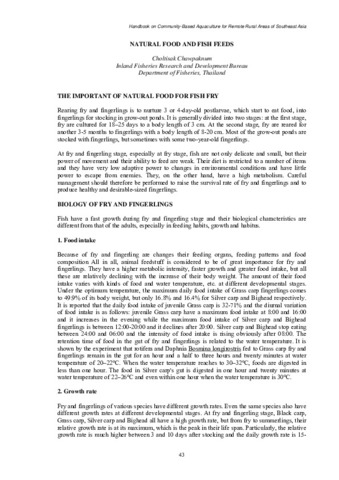Effect of dietary protein and energy level on growth, protein utilization and carcass composition of rabbitfish, Siganus guttatus
Share
Abstract
Six semipurified diets comprising three levels of protein (25, 35, 45% of dry matter) each at two levels of estimated energy (3161, 3832 kcal/kg) were fed to fry for 8 weeks in 250-l tanks at a stocking density of 80 fish/tank. Growth increased with increasing dietary protein \((P\lt0.01)\) and energy \((P\lt0.05)\). Within isocaloric diets, a positive correlation was found between growth and dietary protein-to-energy \(\left(\frac{P}{E}\right)\) ratio \((P\lt0.05)\). Protein productive value (PPV) and protein efficiency ratio (PER) were negatively correlated with dietary \(\left(\frac{P}{E}\right)\) ratio. The equations describing this trend were: \(\mathsf{PPV}=50.16-0.19X\) and \(\mathsf{PER}=2.83-0.12X\), where \(X\) is \(\left(\frac{P}{E}\right)\). Based on responses for growth rate and efficiency of protein utilization, a diet with 35% protein and 3832 kcal/kg energy was found to be best for rabbitfish fry. Carcass fat levels increased in those fish fed diets with 3832 kcal/kg energy. Carcass protein and ash percentages remained essentially constant and independent of dietary treatment.
Suggested Citation
Parazo, M. M. (1990). Effect of dietary protein and energy level on growth, protein utilization and carcass composition of rabbitfish, Siganus guttatus. Aquaculture , 86(1), 41-49. https://doi.org/10.1016/0044-8486(90)90220-H
Subject
Collections
- AQD Journal Articles [1249]
Related items
Showing items related by title, author, creator and subject.
-
Artificial diet development [for abalone]
Aldon, Eva (Aquaculture Department, Southeast Asian Fisheries Development Center, 1997) -
Utilizing alternative ingredients in aquafeeds for sustainable aquaculture
Aya, Frolan A. (Secretariat, Southeast Asian Fisheries Development Center, 2017)Aquaculture is considered as the key to ensuring enough food protein to feed the growing world population (FAO, 2014). It is expected that the global food demand will increase to 70% in 2050. Aquaculture is touted as the ... -
Natural food and fish feeds
Chawpaknum, Choltisak (Secretariat, Southeast Asian Fisheries Development Center, 2008)Rearing fry and fingerlings is to nurture 3 or 4-day-old postlarvae, which start to eat food, into fingerlings for stocking in grow-out ponds. It is generally divided into two stages: at the first stage, fry are cultured ...





